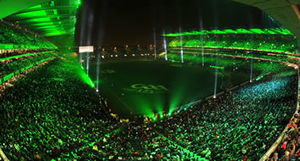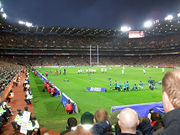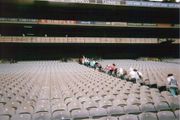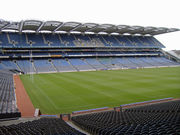Croke Park
| Páirc an Chrócaigh | |
|---|---|
 |
|
| Location | |
| County | Dublin |
| Country | Ireland |
| Facility Statistics | |
| Broke ground | 1884 |
| Opened | 1913 |
| Renovated | 2004 |
| Owner | Gaelic Athletic Association |
| Surface | Desso GrassMaster |
| Reconstruction cost | € 260 million |
| Architect |
Architect Horgan Lynch & Partners |
| Capacity | 82,300 (Field Dimensions: 144.5 m x 88m) |
Croke Park (Irish: Páirc an Chrócaigh, IPA: [ˈpaːɾʲc ən̪ˠ ˈxɾˠoːkˠə]) in Dublin, Ireland is the principal stadium and headquarters of the Gaelic Athletic Association (GAA), Ireland's biggest sporting organisation. The stadium is in the heart of the city, a 15 minute walk from the main thoroughfare O'Connell Street[1].
Since 1884 the site has been used primarily by the GAA to host Gaelic games, most notably the annual finals of the All-Ireland Senior Football Championship and Senior Hurling Championship. Music concerts by major international acts have also been held in "Croker", as it is often called by Dubliners[1], and it hosted the opening and closing ceremonies of the 2003 Special Olympics. During the refurbishment of Lansdowne Road the stadium also hosted the Irish national rugby union and soccer teams.
Following a redevelopment programme started in the 1990s, Croke Park has a capacity of 82,300,[2] making it the third largest stadium in Europe. It has also held the world record for largest attendance at a club/provincial rugby union match since 2 May 2009.[3]
Contents |
History

The area now known as Croke Park was originally an Athletics Course known variously as the City and Suburban Racecourse and "Jones Road" sports ground, the original home of Bohemian F.C.. It was originally owned by Maurice Butterly. From the foundation of the association in 1884 this sportsground was used by the organisation regularly for Gaelic games and Athletics. In 1896 both All-Irelands were played in the ground signifying the growing importance of the suburban plot for the ever expanding GAA. In 1901 Jones's Road hosted the IFA Irish Cup final when Cliftonville defeated Freebooters.[4]
Recognising the potential of the Jones Road sportsground a journalist and GAA member, Frank Dineen, borrowed much of the £3,250 asking price and bought the ground personally in 1908. Only in 1913 did the GAA come into exclusive ownership of the plot when they purchased it from Dineen for £3,500. Once bought, the ground became known as Croke Park in honour of Archbishop Thomas Croke, one of the GAA's first patrons.
In 1913 Croke Park had two stands on what is now known as the Hogan stand side and grassy banks all round. In 1917, the rubble from the Easter Rising in 1916 was used to construct a grassy hill on the railway end of Croke Park to afford patrons a better view of the pitch, which hosted all major football and hurling matches in the latter stages of the All-Ireland championships. This terrace is known as Hill 16.
During the Irish War of Independence on November 21, 1920 Croke Park was the scene of a massacre by the Royal Irish Constabulary (RIC). The Police, supported by the British Auxiliary Division entered the ground, shooting indiscriminately into the crowd killing or fatally wounding 12 during a Dublin-Tipperary gaelic football match. The dead included 11 spectators and Tipperary's captain, Michael Hogan. Posthumously, the Hogan stand built in 1924 was named in his honour. These shootings, on the day which became known as Bloody Sunday, were a reprisal for the assassination of 14 British Intelligence officers, known as the Cairo Gang, by Michael Collins's 'squad' earlier that day.
In the 1920s the GAA set out to create a high capacity stadium at Croke Park. Following the Hogan Stand, the Cusack Stand, named after Michael Cusack from Clare (who founded the GAA and served as its first secretary), was built in 1927. 1936 saw the first double-deck Cusack Stand open with 5,000 seats, and concrete terracing being constructed on Hill 16. In 1952 the Nally Stand was built in memorial of Paddy Nally, another of the GAA founders. Seven years later, to celebrate the 75th anniversary of the GAA, the first cantilevered "New Hogan Stand" was opened.
The highest attendance ever recorded at an All-Ireland Senior Football Final was 90,556 at the 1961 Offaly v Down final. Since the introduction of seating to the Cusack stand in 1966, the largest crowd recorded has been 84,516.
Stadium design
In the 1980s the organisation decided to investigate ways to increase the capacity of the old stadium. The design for an 80,000 capacity stadium was completed in 1991. Gaelic Sports have special requirements as they take place on a large field. A specific requirement was to ensure the spectators were not too far from the field of play. This resulted in the three-tier design from which viewing games is possible: the main concourse, a premium level incorporating hospitality facilities and finally an upper concourse. The premium level contains restaurants, bars and conference areas. The project was split into four phases over a 14-year period.
Phase one
The first phase of construction was to build a replacement for Croke Park's Cusack Stand. Completed in 1995 at a cost of £35 million, the new stand is 180 metres long, 35 metres high, has a capacity for 25,000 people and contains 46 hospitality suites. The new Cusack Stand contains three tiers from which viewing games is possible: the main concourse, a premium level incorporating hospitality facilities and finally an upper concourse.
Phase two
Phase Two of the development started in late 1998 and involved extending the new Cusack Stand to replace the existing Canal End terrace. It is now known as The Davin Stand (Irish: Ardán Dáimhím), after Maurice Davin, the first president of the GAA. This phase also saw the creation of a tunnel which was later named the Ali tunnel in honour of Muhammad Ali and his fight in Croke Park. [5]
Phase three
Phase Three saw the building of the new Hogan Stand. This required a greater variety of spectator categories to be accommodated including general spectators, corporate patrons, VIPs, broadcast and media services and operation staff. Extras included a fitted-out mezzanine level for VIP and Ard Comhairle (Where the dignatories sit) along with a top-level press media facility. The end of Phase Three took the total spectator capacity of Croke Park to 73,500
Phase four
After the 2003 Special Olympics, construction began in September 2003 on the final phase, Phase Four. This involved the redevelopment of the Nally Stand and Hill 16 into a new Nally End/Dineen Hill 16 terrace. It was officially opened by the then GAA President Seán Kelly on March 14, 2005. For logistical reasons (and, to a degree, historical reasons), and also to provide cheaper high-capacity space, the area is a terrace rather than a stand, the only remaining standing-room in Croke Park. Unlike the previous Hill, the new terrace was divided into separate sections – Hill A (Cusack stand side), Hill B (behind the goals) and the Nally terrace (on the site of the old Nally Stand). The fully redeveloped Hill has a capacity of around 9,000, bringing the overall capacity of the stadium to 82,300. This made the stadium the third-largest in the European Union, after Camp Nou in Barcelona and Wembley Stadium in London. However, the presence of terracing means that for competitive soccer, the capacity is reduced to approximately 73,500, due to FIFA's statutes stating that competitive games must be played in all-seater stadiums.
Future expansion
Although the stadium has completed all four phases, there is speculation that future development will include a roof for the stadium. The Hill 16 end is unlikely to be developed further in the near future with a second upper tier (in line with the other 3 sides) due to the proximity of the railway line and the fact that there are houses immediately behind the raised wall on which the rail line runs. The GAA would have to buy some of the houses on Clonliffe Road to expand Hill 16 to anything more than a terrace. A further complication is that the railway line does not run directly parallel to the end of the pitch, which results in the terrace being smaller at the Hogan Stand side of the pitch.
Pitch

The pitch in Croke Park is a Desso GrassMaster pitch which was laid in 2002 replacing the existing grass pitch. This is a modern development in pitch design which couples natural grass with a stitching of synthethic fibres. The close proximity of the stitching and the natural grass roots growing around the stitching is what gives the pitch its stability and is the key to the success of this type of surface. The system is employed in sports venues in the Netherlands, England and the US.
Since January 2006, a special growth and lighting system called the SGL Concept has been used to assist grass growing conditions, even in the winter months. The system, created by Dutch company SGL (Stadium Grow Lighting), helps in controlling and managing all pitch growth factors, such as light, temperature, CO2, water, air and nutrients.[6]
Floodlighting
With the 2007 Six Nations clash with France and possibly other matches in subsequent years requiring lighting the GAA installed floodlights in the stadium (after planning permission was granted). Indeed many other GAA grounds around the country have started to erect floodlights as the organisation starts to hold games in the evenings, whereas traditionally major matches were played almost exclusively on Sunday afternoons. The first game to be played under these lights at Croke Park was a National Football League Division One match between Dublin and Tyrone on 3 February 2007 with Tyrone winning in front of a capacity crowd of over 81,000 - which remains a record attendance for a National League game, with Ireland's Six Nations match with France following on 11 February.[7] Temporary floodlights were installed for the American Bowl game between Chicago Bears and Pittsburgh Steelers on the pitch in 1997, and again for the 2003 Special Olympics.
Controversy on playing non-Gaelic games

There is great debate in Ireland regarding the use of Croke Park for sports other than those of the GAA. As the GAA was founded as a nationalist organisation to maintain and promote indigenous Irish sport, it has felt honour-bound throughout its history to oppose other, foreign, sports.
Up until the early 1970s, rule 27 of the GAA constitution stated that a member of the GAA could be banned from playing its games if found to be also playing soccer, rugby or cricket. That rule was abolished but rule 42 still prohibited the use of GAA property for games with interests in conflict with the interests of the GAA. The belief was that rugby and soccer were in competition with football and hurling, and that if the GAA allowed these sports to use their ground it may be harmful to Gaelic games, while other sports, not seen as direct competitors with gaelic football and hurling, were permitted, such as the two games of American football (one college game between The University of Notre Dame and The United States Naval Academy, and an American Bowl NFL preseason game between the Chicago Bears and the Pittsburgh Steelers) on the Croke Park pitch during the 1990s.
On 16 April 2005, a motion to temporarily relax rule #42 was passed at the GAA Annual Congress. The motion gives the GAA Central Council the power to authorise the renting or leasing of Croke Park for events other than those controlled by the Association, during a period when Lansdowne Road – the venue for international soccer and rugby matches – is closed for redevelopment. The final result was 227 in favour of the motion to 97 against, 11 votes more than the required two-thirds majority.
In January 2006, it was announced that the GAA had reached agreement with the FAI and IRFU to stage two Six Nations games and four soccer internationals at Croke Park in 2007 and in February 2007, use of the pitch by the FAI and the IRFU in 2008 was also agreed.[8] These agreements were within the temporary relaxation terms, as Lansowne Road will still be under redevelopment until 2010. Although the GAA had said that hosted use of Croke Park would not extend beyond 2008, irrespective of the redevelopment progress, [8] fixtures[9] for the 2009 Six Nations rugby tournament see the Irish rugby team using Croke park for a third season. 11 February 2007 saw the first Rugby Union international to be played there. Ireland were leading France in a Six Nations clash, but lost 17-20 after conceding a last minute (converted) try. Raphael Ibanez scored the first try in that match; Ronan O'Gara scored Ireland's first ever try in Croke Park.
A second match between Ireland and England on 24 February 2007 was politically symbolic because of the events of Bloody Sunday in 1920. [10] There was considerable concern as to what reaction there would be to the singing of the British National Anthem God Save the Queen. Ultimately the anthem was sung without interruption or incident, and applauded by both sets of supporters at the match, which Ireland won by 43-13 (their largest ever win over England in rugby).
On the 24 March 2007 the first soccer match took place at Croke Park. The Republic of Ireland took on Wales in a Euro 2008 Qualifier, in which a Stephen Ireland goal secured a 1-0 win for the Irish in front of a crowd of 72,500. Prior to this, the IFA Cup had been played at the then Jones' Road in 1901, but this was 12 years before the GAA took ownership.
World record attendance
On May 2, 2009, Croke Park was the venue for a Heineken Cup rugby semi-final, in which Leinster defeated Munster 25–6. The attendance of 82,208 set a new world record attendance for a club/provincial rugby union game.[3]
Concerts
Past & Future concerts at Croke Park
| Date | Artist | Event |
|---|---|---|
| 29 June 1985 | U2 | The Unforgettable Fire Tour |
| 28 June 1986 | Simple Minds | Once Upon A Time Tour |
| 27 & 28 June 1987 | U2 | The Joshua Tree Tour |
| 28 June 1996 | Tina Turner | Wildest Dreams Tour |
| 16, 17 & 18 May 1997 | Garth Brooks | |
| 24, 25 & 27 June 2005 | U2 | Vertigo Tour |
| 20 May 2006 | Bon Jovi | Have A Nice Day Tour |
| 9 June 2006 | Robbie Williams | Close Encounters Tour |
| 29 July 2006 | Billy Joel | |
| 6 October 2007 | The Police | The Police Reunion Tour |
| 30 May 2008 | Celine Dion | Taking Chances World Tour |
| 1 June 2008 | Westlife | Back Home Tour |
| 14 June 2008 | Neil Diamond | |
| 13 June 2009 | Take That | Take That Presents: The Circus Live |
| 24, 25 & 27 July 2009 | U2 | U2 360° Tour |
| 5 June 2010 | Westlife | Where We Are Tour |
Gallery
 Rugby pitch laid out on the larger Gaelic games pitch |
 |
 Hogan Stand |
2003 Special Olympics Opening Ceremony |
See also
- List of GAA Stadiums by Capacity
- Camogie
- International Rules
- Gaelic football
- Hurling
- Handball
- Sport in Ireland
- Stadiums of Ireland
- Hill 16
References
- ↑ Directions to Croke Park
- ↑ Croke Park Venue Information
- ↑ 3.0 3.1 Leinster 25-6 Munster. BBC Sport (2nd May 2009)
- ↑ Irish FA Cup (1901-1910) - Irish FA Cup (1901-1910)
- ↑ "Rate Card". http://www.cbsoutdoor.ie/upload/124178_672_1199817564120-FAI__Rate_Card_2008_2009.pdf. Retrieved 2009-03-17.
- ↑ SGLCONCEPT.COM | Stadium Grow Lighting | SGL Concept
- ↑ "Dublin and Tyrone look set to play under lights". http://www.rte.ie/sport/2006/1128/crokepark.html. Retrieved 2007-01-12.
- ↑ 8.0 8.1 "Croker to host rugby and soccer in 2008". http://www.rte.ie/sport/2007/0217/crokepark.html. Retrieved 2007-02-19.
- ↑ "official fixture list". http://www.rbs6nations.com/en/matchcentre/match-centre_fixtures-results.php. Retrieved 2008-05-08.
- ↑ "Symbolic step of peace at Irish stadium". http://www.csmonitor.com/2007/0223/p06s01-woeu.html. Retrieved 2007-02-25.
External links
- Croke Park Official site
- Croke Park Undersoil Heating
|
|||||||||||||||||||||||||||||||||||||||||||||||||||||||||||||||||||||||||||||||||||||||||||||||||||||||||||||||||||||||||||||||||||||||
|
|||||